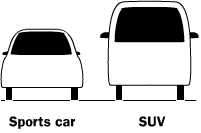by Julia Layton and Karim Nice
The key to a hybrid car is that the gasoline engine can be much smaller than the one in a conventional car and therefore more efficient. Most cars require a relatively big engine to produce enough power to accelerate the car quickly. In a small engine, however, the efficiency can be improved by using smaller, lighter parts, by reducing the number of cylinders and by operating the engine closer to its maximum load.
There are several reasons why smaller engines are more efficient than bigger ones:
- The big engine is heavier than the small engine, so the car uses extra energy every time it accelerates or drives up a hill.
- The pistons and other internal components are heavier, requiring more energy each time they go up and down in the cylinder.
- The displacement of the cylinders is larger, so more fuel is required by each cylinder.
- Bigger engines usually have more cylinders, and each cylinder uses fuel every time the engine fires, even if the car isn't moving.
This explains why two of the same model cars with different engines can get different mileage. If both cars are driving along the freeway at the same speed, the one with the smaller engine uses less energy. Both engines have to output the same amount of power to drive the car, but the small engine uses less power to drive itself. But how can this smaller engine provide the power your car needs to keep up with the more powerful cars on the road?
Let's compare a car like the Chevy Camaro, with its big V-8 engine, to our hybrid car with its small gas engine and electric motor. The engine in the Camaro has more than enough power to handle any driving situation. The engine in the hybrid car is powerful enough to move the car along on the freeway, but when it needs to get the car moving in a hurry, or go up a steep hill, it needs help. That "help" comes from the electric motor and battery -- this system steps in to provide the necessary extra power.
The gas engine on a conventional car is sized for the peak power requirement (those few times when you floor the accelerator pedal). In fact, most drivers use the peak power of their engines less than one percent of the time. The hybrid car uses a much smaller engine, one that is sized closer to the average power requirement than to the peak power.
Besides a smaller, more efficient engine, today's hybrids use many other tricks to increase fuel efficiency. Some of those tricks will help any type of car get better mileage, and some only apply to a hybrid. To squeeze every last mile out of a gallon of gasoline, a hybrid car can:
Recover energy and store it in the battery - Whenever you step on the brake pedal in your car, you are removing energy from the car. The faster a car is going, the more kinetic energy it has. The brakes of a car remove this energy and dissipate it in the form of heat. A hybrid car can capture some of this energy and store it in the battery to use later. It does this by using "regenerative braking." That is, instead of just using the brakes to stop the car, the electric motor that drives the hybrid can also slow the car. In this mode, the electric motor acts as a generator and charges the batteries while the car is slowing down.
Sometimes shut off the engine - A hybrid car does not need to rely on the gasoline engine all of the time because it has an alternate power source -- the electric motor and batteries. So the hybrid car can sometimes turn off the gasoline engine, for example when the vehicle is stopped at a red light.
Use advanced aerodynamics to reduce drag - When you are driving on the freeway, most of the work your engine does goes into pushing the car through the air. This force is known as aerodynamic drag. This drag force can be reduced in a variety of ways. One sure way is to reduce the frontal area of the car. Think of how a big SUV has to push a much greater area through the air than a tiny sports car.
Reducing disturbances around objects that stick out from the car or eliminating them altogether can also help to improve the aerodynamics. For example, covers over the wheel housings smooth the airflow and reduce drag. And sometimes, mirrors are replaced with small cameras.
(Picture right: The frontal area profile of a small and large car)
Use low-rolling resistance tires - The tires on most cars are optimized to give a smooth ride, minimize noise, and provide good traction in a variety of weather conditions. But they are rarely optimized for efficiency. In fact, the tires cause a surprising amount of drag while you are driving. Hybrid cars use special tires that are both stiffer and inflated to a higher pressure than conventional tires. The result is that they cause about half the drag of regular tires.
Use lightweight materials - Reducing the overall weight of a car is one easy way to increase the mileage. A lighter vehicle uses less energy each time you accelerate or drive up a hill. Composite materials like carbon fiber or lightweight metals like aluminum and magnesium can be used to reduce weight.
All of the hybrid cars on the market utilize some or all of these efficiency tricks. Let's take a look at the hybrid models you can buy right now.
No comments:
Post a Comment